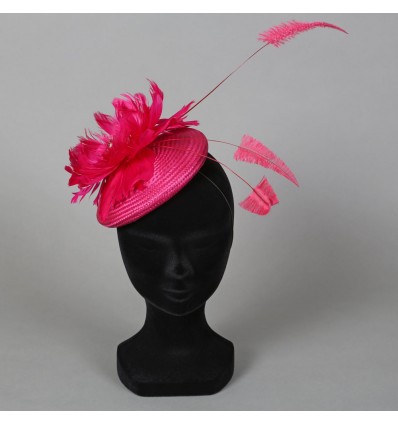No products
Product successfully added to your shopping cart
There are 0 items in your cart. There is 1 item in your cart.
Hat "Puck"
COK-galet-bunt
New
Women who like to stand out for their style and use of bold colours will love this Cocktail hat. A striking profusion of flowers and feathers all in the same tone, on a straw disc from where three long-stemmed palms arise, inclined slightly to the side. Perfect for those events that require elegance and glamour.
More info
Hat "Puck"
Hats and similar accessories to protect the head have been a part of women’s clothing since the earliest centuries of the Christian era. During the Middle Ages (476-1453) women could not display their hair for religious reasons. They wore a piece of fabric over their heads which hung to their shoulders to hide their hair, a practice reminiscent of veils in certain religions to this day. Even now, in certain cultures it is necessary that a woman entirely covers her head with the likes of a chador, burka or the scarf worn by Muslim women.
We have observed hoods decorated with jewellery and embroidery at the beginning of the 16th century. Up until the end of the 18th century women demonstrated their social status with various head-coverings which differentiated them, whether by style and materials or by the decorations employed in the making of their hats.
After the French Revolution many women started to wear wide-brimmed hats made from assorted materials like velvet, felt, leather, straw and light fabrics, secured by a ribbon tied under the chin. Half a century later these were replaced by hats attached to the hair by clips which were invented in 1850.
However, some people mistakenly thought that, with the advent of clips, the wearing of hats was restricted to certain types of hair. In fact this method of securing hats evolved and one could see enormous hats covering voluminous hair-styles at the start of the 20th century.
Then suddenly the world was subjected to a big shake-up. The First World War started in the middle of the second decade of the 20th century and then twenty years after that there was the Second World War. The planet would never be the same again. Everybody, regardless of social class, suffered immense changes in habits, customs, ways of life and forms of dress.
The people suffered food shortages, and needless to say, there was a shortage of materials to make clothes and accessories during the periods of world conflict. However there remained a degree of creativity in hat-making. The enormous hats with their exaggerated brims were finally succeeded by smaller and more discreet hats which were easier to create with fewer materials. The cocktail hat was at its zenith in the 50s and can be identified in the magazines and films of the period. The variety of sizes and styles of adornments of the Cocktail Hat and the refined elegance it gives the wearer has always attracted attention in the special moments when it would express charm and seductive ability.
The cocktail hat has made a strong come-back thanks to Kate, the United Kingdom’s Duchess of Cambridge. Prince William’s refined wife has show-pieced different models on many occasions: during international trips, on diplomatic missions, at British court festivities, and at occasions from society weddings and official receptions, to the celebrations for the Queen’s (90th) birthday. One sees her wearing different materials suited to the climate, with heavier fabrics in winter and lighter ones in summer, and usually in the same colours as her outfits.
Whether or not influenced by the Duchess of Cambridge, it is true to say those women the world over are adopting cocktail hats which have the structure of a normal hat but are of a smaller size. The decorations could be a little flower on one side, or a combination of large flowers, bows, feathers and veils to give a larger volume. The current fashion of wearing a cocktail hat shows the care a woman takes to demonstrate her personality while being refined and chic.
Generally speaking the hat is worn on the side of the head or tilted forward, showing all or part of the forehead which may be covered by a short veil. In other words, the cocktail hat does not hide the woman’s face, but on the contrary, accentuates it. The cocktail hat can be made with silk, satin, organza, felt or velvet and can be in a monotone, in matching shades or even in several colours. It can be embellished with little gemstones or other more sparkling accessories.
Like many women’s hats there are rules about the hours they can be worn, which with a cocktail hat is preferably only up until 4p.m. They are never worn in the evening, no matter what the occasion.
Like other millinery, they should harmonize with the wearer’s outfit both in terms of colour and decoration. The rule “Less is more” applies.
Data sheet
| Manufacturing | Pebble Buntal or Palm tree trimmed with feathers and flowers, Fuschia color. |
Your Hat Cases
 My desire was to create beautiful hat cases, cases that combine elegance, functionality and refinement. For this, I called upon my friend, the very talented Brazilian designer Gabriela Goldschmidt De La Fuente. The main design objective was to create an image that reference the G in the Gedilva logo, perfectly representing the brand signature. Gabriela created a sleek and dynamic design in two colors that created strong visual recognition of the brand. The motifs representing a stylized G, refer back to the logo to give a very aesthetically appealing look.
My desire was to create beautiful hat cases, cases that combine elegance, functionality and refinement. For this, I called upon my friend, the very talented Brazilian designer Gabriela Goldschmidt De La Fuente. The main design objective was to create an image that reference the G in the Gedilva logo, perfectly representing the brand signature. Gabriela created a sleek and dynamic design in two colors that created strong visual recognition of the brand. The motifs representing a stylized G, refer back to the logo to give a very aesthetically appealing look.
I wanted the hat cases to be fabricated in France. French craftsmanship represents the highest manufacturing quality and expertise in luxury items. I selected Multi Services Carton in Paris, who have specialized in producing luxury packaging for many years. Each of my cases is made exclusively by hand with flawless manufacturing quality.
I wanted a case that would be representative of the quality of my brand, and that matched the style and panache of the hat within the case. When you purchase a Gedilva designed hat, you will possess a high fashion and high quality hat and case set that will accompany you throughout your life.




